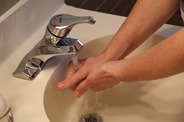November 2016
Food Digest is a quarterly newsletter written by inspectors from your local health department to support and educate Hennepin County food facility owners and managers about food safety in accordance with the Minnesota Food Code 4626.

One employee in each establishment
must have a current Certified Food Manager certificate. This must be posted
conspicuously on-site in accordance with the Minnesota Food Code.
To look up a Certified Food Manager, you can visit the Minnesota Department of
Health’s website.
We welcome comments or ideas about our newsletter.
Hannah Marschinke
612-543-5255
Amy Zagar
612-543-5267
|
Disposable plastic gloves can be an easy way
to comply with the “no bare hands” rule for handling and serving ready-to-eat
foods (see section from Hennepin County Ordinance below). But their improper
use can just as easily defeat their purpose. Improper glove use can occur
many ways, some more critical than others.
From raw meat to ready-to-eat -- Cross contamination can occur when gloves are not
switched out while working with both raw and ready-to-eat foods. It is critical that gloves are changed when
going from handling raw meat and other potentially hazardous foods to
handling ready-to-eat foods. Not doing
this could result in restaurant patrons becoming ill due to a food borne
illness.
Gloves on, discard, repeat – Even when doing a seemingly safe task repeatedly,
gloves still should be changed out frequently, a fact many forget. A clean
glove at the beginning of a work shift does stay clean until the end. Touching one’s face, hair, unclean surfaces
or going to the bathroom make gloves unclean. The frequent changing of gloves
guards against the transfer of germs to food.
As clean as the hand that puts it on -- Another common mistake occurs when people don’t wash
their hands before and between wearing gloves. Gloves do not replace hand
washing. Hands should still be washed at regular intervals throughout the day
so they’re always clean when picking up and putting on fresh gloves.
Hennepin
County Ordinance 3:
Section 7: STANDARDS FOR HEALTH, SAFETY, AND NUISANCE
PREVENTION.
7.1 Standards Adopted. This Ordinance incorporates by reference the
provisions of Minnesota Rules, Chapters 4626.0010 through 4626.2025,
excluding 4626.1715 subpart B, 4626.1720 subpart B, and 4626.1755 through
4626.1780, and all subsequent recodifications and amendments, and
specifically adopts the following additional standards pursuant to Minnesota
Statute, Section 145A.05, subdivision 1:
B. Minnesota
Rules, Chapter 4626.0225 PREVENTING CONTAMINATION FROM HANDS.
1. Food employees shall wash their hands as specified in part 4626.0070.
2. Food employees shall not contact exposed ready-to-eat food with their bare hands and shall use suitable utensils such as deli tissue, spatulas, tongs, single-use gloves, or dispensing equipment except;
(a) When washing fruits and vegetables as specified in part 4626.0255,
or
(b) When otherwise approved by the Health Authority. The Health Authority shall not approve alternatives in those establishments serving highly susceptible populations.
3. Food employees shall minimize bare hand and arm contact with food that is not in a ready-to-eat form.
Back to top
 Handwashing with soap and water is the single most effective
way to prevent the spread of bacteria and viruses - the major causes of food-borne
illness. Alcohol-based hand sanitizers are effective in killing bacteria and
some viruses on clean hands. However, sanitizers may not be used instead
of handwashing by food service employees.
Why can’t hand sanitizers be used instead of handwashing
in food service settings?
The hands of food workers are often wet and often contaminated
with fatty material or with food high in proteins. The presence of water, food,
fatty materials, feces and blood on the hands can significantly reduce the
effectiveness of an alcohol-based hand sanitizer. Viruses such as norovirus are
also a concern in food service settings. Norovirus is the leading cause of food-borne
outbreaks. Hand sanitizers do not kill norovirus.
Washing with soap and water is the most effective way to remove the types of
pathogens that foodworkers have on their hands. In order for hand sanitizers to
work properly, hands must first be washed with soap, rinsed with running water
and completely dried.
The Minnesota Food Code requires handwashing with soap and water in food
service establishments.
When can hand sanitizers be used
in a food service setting?
The FDA Food Code and the Minnesota Food Code allow the use
of hand sanitizers by food workers after proper handwashing.
Can food establishments provide hand sanitizers for customers?
Food service establishments may provide hand sanitizers for use by the public, in addition to proper handwashing facilities.
NOTE: Your employee hygiene policy should include
handwashing procedures, plus guidelines for hand sanitizer use, and exclusion
of foodworkers who have symptoms of diarrhea and/or vomiting.
Back to top
|
Visit www.hennepin.us/envhealth for information on:
- General environmental health
- Basic food safety classes
- Temporary food stand licensing
- Food license information, categories, and fee schedule
- New construction or remodeling application
Radon information and
test kits
www.hennepin.us/radon
Septic system
requirements and procedures
www.hennepin.us/septic
Body art licensing
information (tattooing and piercing)
www.hennepin.us/bodyart
Beaches in Hennepin
County
www.hennepin.us/beaches
Visit www.hennepin.us/envhealth to subscribe to our e-newsletter.
|